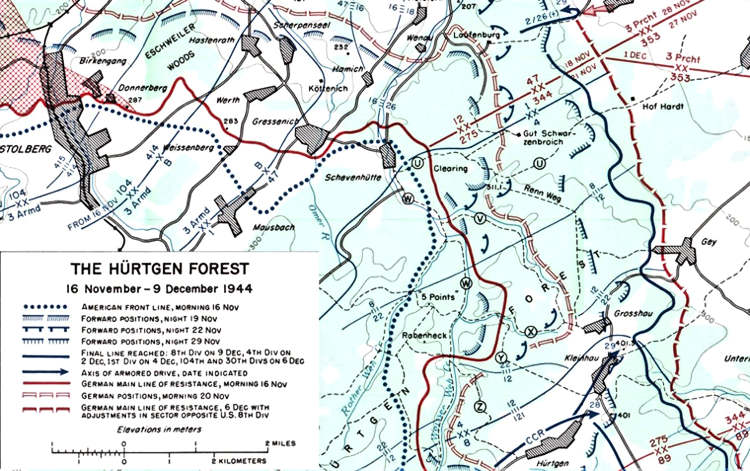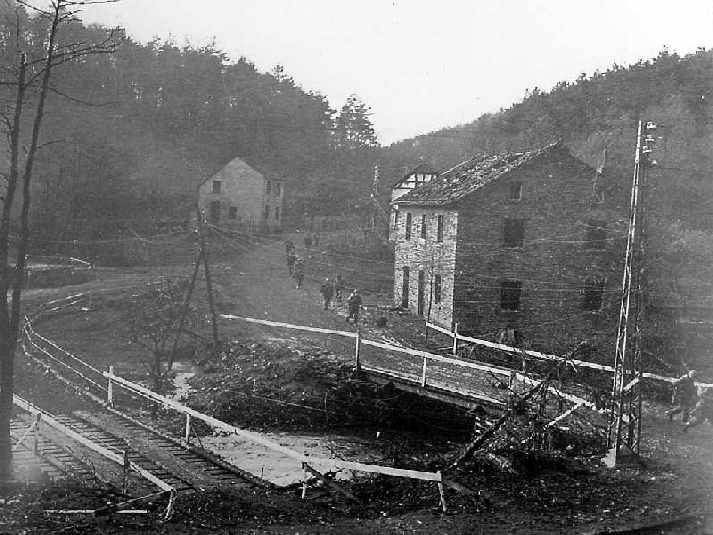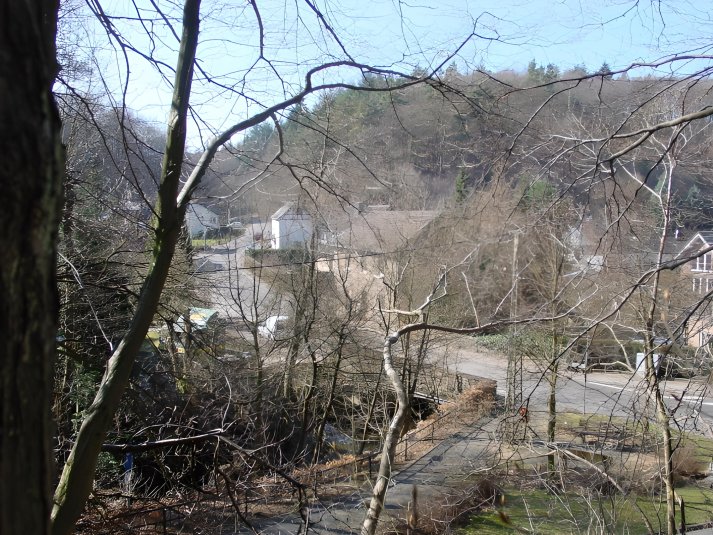4TH INFANTRY DIVISION
FOR THE PERIOD 1 NOVEMBER - 30 NOVEMBER

HEADQUARTERS 8TH INFANTRY
APO 4
UNITED STATES ARMY.
1 November 1944
On the 1st of November, the 8th Infantry was still opposed by elements of the 7th AF Festung Battalion, the 4th AF Festung Battalion and the 412th Training Battalion. The enemy continued defensive along the line of bunkers which comprised the Siegfried Line, maintaining outposts, delivering harassing small arms and artillery fires upon the 8th Infantry northern sector. The 1st Battalion remained in Regimental Reserve and conducted training in Company Attack problems in conjunction with supporting tanks ands weapons. The 2nd and 3rd Battalions continued to hold the main line of resistance, sending patrols into "No Man's Land", to deny its use to the enemy. Enemy action was largely sporadic and ineffective against the Regiment.
2 November 1944
The 1st Battalion relieved the 2nd Battalion in its defensive sector at 1415, having been shuttled by truck to the front. The 3rd Battalion held its current defensive position on the right front of the Regiment. Late in the afternoon, the 2nd Battalion returned to an assembly area in Hunningen, where it prepared for several days of training to further orient new men witch tactics which would probably be used in forthcoming operations. The enemy remained within their "bunker line", delivering harassing small arms and occasional mortar and artillery fires in the forward area of the Regiment.
3 November 1944
The 1st and 3rd Battalions sent strong patrols into enemy territory to determine positions of enemy outposts, minefields, and to capture prisoners. German troops in the opposing line harassed 8th Infantry patrols and front line positions with heavy machine gun fire, but caused few casualties. 1st and 3rd Battalion patrols captured four enemy prisoners, who, while being questioned by the 8th Infantry IPW team, exhibited extremely low morale and revealed that their comrades within the Siegfried fortifications held little hope for victory. Enemy long range artillery became more active and increasing numbers of robot bombs were sent across the Regimental Sector toward rear installations. Although the Cannon Company was unable to fire due to restrictions on ammunition, supporting artillery was active.
4 November 1944
Elements of the 7th AF Festung Battalion, 4th AF Festung Battalion and 412th Training Battalion continued to oppose the 8th Infantry from a defensive position in the Siegfried Bunker Line, delivering harassing small arms, mortar and artillery fire throughout the day. The weather continued cold and rainy. The 3rd Battalion on the right, the 1st Battalion on the left, continued to hold the Regimental Front, sending patrols into "No Man's Land", to capture enemy personnel and obtain information of German activities. The 2nd Battalion, remaining in Regimental Reserve at Hunningen, conducted problems in "woods fighting" and the "attack of a river line". Reconnaissance parties were sent to a new area in preparation for a move by the Regiment to a new sector.
5 November 1944
On the following day, the enemy employed harassing fires, delivered upon the 8th Infantry Sector, and sent two strong patrols against our lines, both of which were repulsed. German troops, remaining within their Siegfried fortifications, seemed content to improve their defensive positions. A billeting party, consisting of fifteen officers and 30 enlisted men from the 8th Infantry and attached units comprising the combat team, under the command of Lt Col Bates, left Hunningen at 0745 to reconnoiter an assembly area and make the necessary billeting arrangements prior to the movement of the combat team to another sector. By 1830, complete relief of the 8th Infantry had been effected by elements of the 9th Infantry Division. The 1st and 3rd Battalions, Anti-Tank and Cannon Companies, were relieved by the 39th and 60th Infantry Regiments. The 8th Infantry then moved into an assembly area at Hunningen, preparing to move to its new sector.
6, 7, 8 November 1944
The movement to the new sector was postponed by Division for 24 hours. The 8th Infantry remained in bivouac near Hunningen during the night. At 1345 on November 7th, an advance group, consisting of fifty general purpose vehicles, crossed the IP enroute to the new area. At 2200, the remainder of the Regiment, moving with organic transportation and eighty 2½-Ton Quartermaster trucks, began a night motor march to its new sector. The Regiment continued its movement by motor during the entire night under difficult conditions of rain and muddy roads. Poor visibility during the blackout caused 31 vehicles to slide off the road into the ditch, two of which overturned, resulting in six casualties. Upon arrival in the new sector, the Regiment immediately began the construction of defensive positions with overhead cover and made preparations for the attack towards Düren. No contact was made with the enemy during the initial occupation of this area which was behind a line held by the 47th Infantry Regiment. Plans were made to reconnoiter forward areas opposing the German defense positions to determine a line of departure for the proposed operation.
9, 10 November 1944
The Regiment remained in its current area, continuing preparations for the attack. Battalion Commanders, Company Commanders and platoon leaders reconnoitered the 47th Infantry Regiment's defense line through which the attack was to be made. The weather continued cloudy with intermittent rains. The 8th Infantry, located in the vicinity of Zweifall, Germany, awaited the order for attack, which was postponed by rain and snow. The Regiment remained in its assembly area, harassed by snow, light rain and increasing enemy artillery, attempted to dig in deeper. Because of continuous rains, slit trenches could not be dug more than a few inches deep before water would seep in. Therefore, construction of overhead log shelters was essential for protection against tree bursts from artillery as well as the elements.
11 - 15 November 1944
On November 11th, overcast, rainy weather again delayed the attack. D-day was postponed for an additional 24 hours, during which time the troops continued preparations for the jump-off. Additional reconnaissance of the proposed Regimental Sector was made and planning and coordination of each unit's role was further studied and improved. The 2nd Battalion moved to its forward assembly area and secured itself for the night. At 11 o'clock, Cannon Company moved to a forward position to prepare for support of the Infantry. Enemy artillery, increasing in activity, continued to harass 8th Infantry troops. Toward nightfall, the weather improved somewhat and indicated that the weather on the following day might be favorable. The roads were still muddy, making transportation of heavy vehicles and tanks extremely difficult.
For the past six weeks, the enemy in the sector now opposed to the 8th Infantry, had well prepared defensive positions and reorganized mixed elements which had been shattered by the American advance across France and Belgium. Extensive field works had been dug, protected by obstacles consisting of wire, road-blocks and minefields. Perhaps the greatest element of enemy camouflage and protection was the thick pine forest stretching for miles along the German front. The trees were so closely spaced, the foliage so dense, that it was difficult to penetrate, and afforded the enemy excellent concealment. Although there had been no recent identification of the enemy opposite the proposed 8th Infantry Sector, it was believed that the 365th Training and Replacement Battalion and other elements of the 275th Division were occupying this sector.
This operation was to be one of the largest coordinated attacks to participated in by the 4th Infantry Division since the breakthrough from Normandy on July 25th. The 4th Division was to attack in conjunction with the 1st Infantry Division on the left to seize the crossings of the Roer River near Düren, then drive northeast and seize Cologne. The 8th Infantry and attached units (Company A, 4th Medical Battalion; one platoon of Company A, 4th Engineer Battalion; two platoons, Companies A and D, 70th Tank Battalion; one platoon 803rd Tank Destroyer Battalion; and the 29th Field Artillery Battalion in support) were to attack in conjunction with the 26th Infantry Regiment of the 1st Division on its left and with the 22nd Infantry Regiment of the 4th Division on its right. The attack was to be supported by Fighter and Heavy Bombers.

16 November 1944
Notice was received from Division Headquarters early on the morning of November 16th that the Fighter Bombers would attack initial enemy targets at 161115A Nov 1944, consisting of pill-boxes, field fortifications and lines of supply and reinforcement. H-hour was designated for 161245A Nov 1944. The 2nd Battalion began moving forward at 0830 into the 47th Infantry Sector and relieved Company F, 47th Infantry at 160955A Nov 1944, preparing to remain in that area until H-hour. The 1st Battalion in turn occupied positions evacuated by the 2nd Battalion in the rear of the 47th Infantry Sector. Bombing commenced at the scheduled hour. 8th Infantrymen remained in their slit trenches during the bombing for protection from bombs and enemy counter-fire.
At 161245A Nov 1945, the 2nd Battalion attacked German fortified positions southwest of Düren, Germany, in conjunction with the attack of the 26th Infantry Regiment of the 1st Infantry Division. It was the leading assault battalion of the regiment and began its attack after a heavy preparation of artillery fire. The Battalion crossed the line of departure on schedule and proceeded through a wooded area up a steep hill where a heavy concentration of enemy 150mm artillery fire and 120mm mortar fire was placed upon them, inflicting a great number of casualties in Companies E and G. The Battalion then continued to advance some five hundred yards and finally was held up by three rows of heavy concertina wire covered by machine gun and small arms fire. Here again the 2nd Battalion was subjected to terrific artillery and mortar fire, causing an additional large number of casualties.
When the Battalion was first subjected to artillery and mortar fire, the company aid men and litter squads of the 2nd Battalion Medical Section immediately aided and assisted the wounded, alleviating their pain as much as possible at that time with the medical supplies which they carried. After treatment by the aid men, the wounded were then carried to the Battalion Aid Station by litter squads for further treatment. This evacuation by the litter squads was carried on through heavy artillery and mortar concentrations over difficult terrain and down a high hill which was so steep as to be almost impossible to negotiate litters. The work continued all during the night and morning of the following day and finally at 1400 on 17 November the evacuation of the wounded of the 2nd Battalion was completed. When time could be taken to make a count of the casualties carried in from the field, it was found that the total was 147, including five members of the medical personnel. After all casualties were evacuated from the field of battle by the medical officers at the battalion, working throughout the night, driving ambulances under most hazardous road conditions in total darkness, was completed with utmost efficiency.
All attempts to breach the concertina wire obstacle with bangalore torpedoes failed, so the Regimental Commander ordered the 2nd Battalion to establish a defensive position for the remainder of the day and night. At 1335, the 1st Battalion moved two companies forward to a hill (coordinate 009414) which had been occupied previously by Companies F and G. At 1510, the 1st Battalion where the 1st and 2nd Battalion lines were tied in and secured for the night which protected the right flank of the Regiment. The enemy, dug in at well prepared emplacements behind minefields, road blocks and wire obstacles, delivered increasingly heavy small arms, machine gun, mortar and artillery fires throughout the evening and night. Elements of the 984th Infantry Regiment, 275 Infantry Division, and other unidentified units, stubbornly defending their lines, were considered likely to launch a heavy counterattack within 48 hours and only fall back to successive points of defense when pressure against them became overwhelming.

November 16, 1944, Soldiers of the 8th Inf Rgt
arriving from Vicht.
(Lamersiefen / Joaswerk, south of Schevenhütte).


